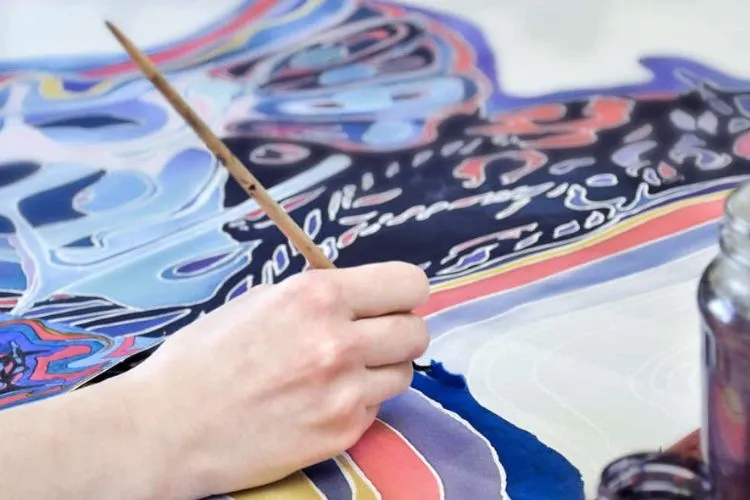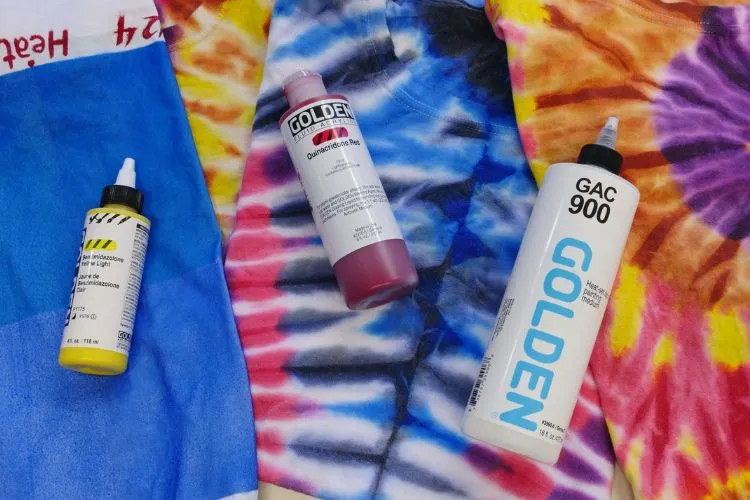When it comes to personalizing fabrics with vibrant designs, acrylic paint is a popular choice due to its accessibility, wide range of colors, and ease of use. But the burning question remains, “Is acrylic paint machine washable?”
This guide aims to provide a thorough understanding of acrylic paint’s behavior on fabric, practical steps for washing painted items, and tips to ensure your designs endure the test of time.

Is Acrylic Paint Machine Washable?
Several factors can determine whether your acrylic-painted fabric items can withstand machine washing. Firstly, the type of fabric plays a critical role; natural fibers like cotton absorb and bond with paint better than synthetic fibers.
Secondly, adding a fabric medium to acrylic paint improves flexibility and adhesion, enhancing washability. Lastly, allowing adequate curing time — typically a week — ensures the paint sets properly before any washing.
The Basics of Acrylic Paint on Fabric
Acrylic paint, a water-based paint known for its quick-drying properties, consists of pigment suspended in acrylic polymer emulsion. On fabric, this type of paint often results in a stiff and durable painted area that stands out against the softness of the material.

The interaction between acrylic paint and fabric fibers is pivotal. The paint creates a plastic-like layer, adhering to the surface but not always penetrating the fibers deeply, unless a fabric medium is involved.
Step-by-Step Guide to Washing Acrylic Painted Fabrics
Washing painted fabrics requires gentle handling to maintain the integrity of the design:
- Pre-wash Considerations: Always turn the garment inside out to minimize surface friction on the painted area. Consider placing the item in a mesh laundry bag for added protection.
- Washing Machine Settings: Use a gentle cycle with cold water. Hot water might cause the paint to soften and deteriorate the design.
- Recommended Detergents and Techniques: Choose mild detergents that are less likely to strip the paint. Avoid bleach and fabric softeners. After washing, either air dry or use a low-heat setting in the dryer. High temperatures can cause the paint to crack.
Tips to Make Acrylic Paint on Fabric Last Longer
To enhance the longevity of painted designs on fabric:
- Using Fabric Medium: Mixing a fabric medium with acrylic paint keeps the painted area flexible and less prone to cracking or peeling.
- Heat Setting Techniques Post-Painting: Ironing the reverse side of the painted area or using a heat press can set the paint more firmly into the fabric.
- Post-Wash Care Tips: Ironing the reverse side after each wash can help maintain the design. Avoid direct ironing on the paint.
Common Problems and Solutions
Even with careful preparation and washing, issues may arise:
- Cracking and Peeling After Wash: This is often due to lack of fabric medium or insufficient heat setting. Applying a thin layer of fabric paint or medium can fix minor issues.
- Stiffness of Paint on Fabric: To reduce stiffness, mix paint with fabric medium or lightly sand the painted area with fine-grit sandpaper after heat setting. Always test on a small area first.
Blending Techniques for Acrylic Paints on Fabric
Blending techniques for acrylic paints on fabric allow artists to create vibrant, dynamic designs with depth and fluidity. When layering colors, it’s crucial to understand how to do so without compromising the washability of the finished piece.
The key is to let each color layer dry completely before applying the next. This prevents the colors from bleeding into each other and ensures the integrity of the design.
For creating wash-resistant gradients and shades, incorporating a fabric medium with acrylic paint is essential.

This mixture not only improves the flow of the paint for smoother transitions but also enhances the flexibility and adhesion of the paint to the fabric, making the design more durable through washes.
By mastering these blending techniques, artists can achieve stunning, lasting results on fabric projects.
You may also like to find out: Does Acrylic Paint Bleed?
Maintenance Advice for Commercially Painted Fabrics
Maintaining the quality and appearance of commercially painted fabrics requires understanding the differences in care between mass-produced and hand-painted items, as well as the specifics of commercial fabric paints. Here are key points to consider:
Caring for Mass-Produced vs. Hand-Painted Fabrics
- Mass-Produced Fabrics: These usually come with care labels that provide specific instructions. Follow these guidelines closely as the fabric and paint have been tested to ensure durability under recommended conditions.
- Machine Washing: Typically, these fabrics can withstand gentle machine washing with mild detergents.
- Drying: Air drying is preferred to preserve the fabric’s integrity and avoid heat damage from dryers.
- Hand-Painted Fabrics: These require a gentler approach.
- Spot Cleaning: Whenever possible, spot clean to avoid extensive exposure to water and detergents.
- Hand Washing: If broader cleaning is necessary, hand wash gently in cold water with a mild detergent.
- Drying: Always air dry away from direct sunlight to prevent fading.
Understanding Commercial Fabric Paints and Their Care Instructions
- Chemical Composition: Commercial fabric paints are formulated to bond permanently with the fabric, often incorporating a fabric medium within the paint to enhance durability.
- Follow Label Instructions: Paint manufacturers provide care instructions that are vital for maintaining the vibrancy and durability of the paint. Always adhere to these specifications.
- Heat Setting: Many commercial paints require heat setting, which might have already been done in the production process for mass-produced items. For hand-painted fabrics with commercial paints, follow the product’s heat-setting instructions to ensure washability.
In both scenarios, avoiding harsh chemicals, bleach, and fabric softeners is crucial as they can break down the paint, causing fading or cracking.
By adhering to these maintenance tips, the longevity and appearance of commercially painted fabrics can be significantly extended, irrespective of whether they are mass-produced or intricately hand-painted.
Frequently Asked Questions (FAQs)
Can I Dry Machine Wash Acrylic Painted Fabrics?
Yes, but use a low-heat or air-dry setting to prevent heat damage.
How Many Washes Can Acrylic Painted Fabric Withstand?
With proper preparation and care, acrylic-painted fabric can withstand multiple washes. The exact number varies based on factors like paint quality, fabric type, and washing methods.
Are There Specific Brands of Acrylic Paint That Are More Wash-resistant?
Some brands formulate acrylic paints specifically for fabric use, which may offer better washability. Always check the product descriptions and guidelines.
Conclusion:
While acrylic paint does lend itself to fabric decoration, its longevity and washability depend on several factors. By choosing the right fabrics, preparing the paint correctly, and following the care guidelines provided, you can enjoy your vibrant designs for many washes to come.
Experimenting with different techniques and products will help you find the best approach for your fabric painting projects. Remember, the key to durability lies not just in the painting process but in the attentive care that follows.

Meet Isabella Anderson, your acrylic painting mentor with over a decade of brush-wielding mastery. Dive into the colorful world of acrylics with her expert guidance, featured exclusively on ‘Acrylic Authority.’ Unleash your inner artist and explore the limitless possibilities of this versatile medium alongside a true acrylic aficionado.
